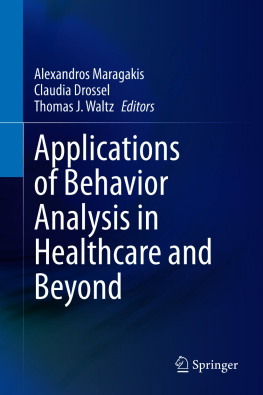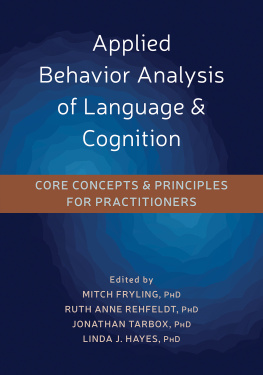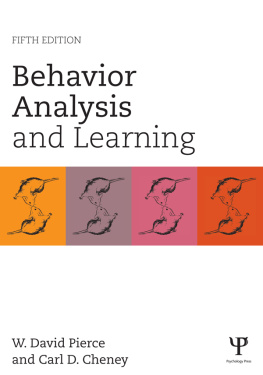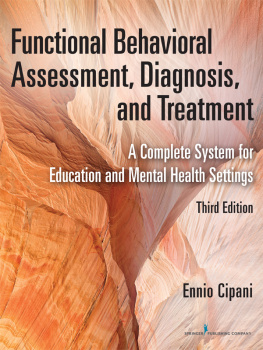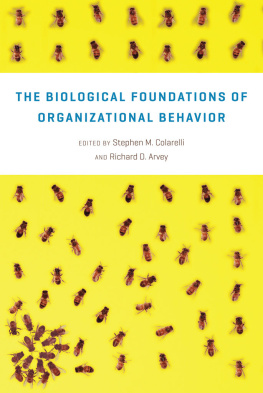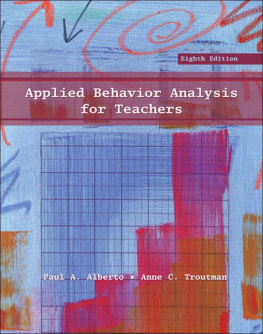Editors
Alexandros Maragakis , Claudia Drossel and Thomas J. Waltz
Applications of Behavior Analysis in Healthcare and Beyond
1st ed. 2021

Logo of the publisher
Editors
Alexandros Maragakis
Department of Psychology, Eastern Michigan University, Ypsilanti, MI, USA
Claudia Drossel
Department of Psychology, Eastern Michigan University, Ypsilanti, MI, USA
Thomas J. Waltz
Department of Psychology, Eastern Michigan University, Ypsilanti, MI, USA
ISBN 978-3-030-57968-5 e-ISBN 978-3-030-57969-2
https://doi.org/10.1007/978-3-030-57969-2
Springer Nature Switzerland AG 2021
This work is subject to copyright. All rights are reserved by the Publisher, whether the whole or part of the material is concerned, specifically the rights of translation, reprinting, reuse of illustrations, recitation, broadcasting, reproduction on microfilms or in any other physical way, and transmission or information storage and retrieval, electronic adaptation, computer software, or by similar or dissimilar methodology now known or hereafter developed.
The use of general descriptive names, registered names, trademarks, service marks, etc. in this publication does not imply, even in the absence of a specific statement, that such names are exempt from the relevant protective laws and regulations and therefore free for general use.
The publisher, the authors and the editors are safe to assume that the advice and information in this book are believed to be true and accurate at the date of publication. Neither the publisher nor the authors or the editors give a warranty, expressed or implied, with respect to the material contained herein or for any errors or omissions that may have been made. The publisher remains neutral with regard to jurisdictional claims in published maps and institutional affiliations.
This Springer imprint is published by the registered company Springer Nature Switzerland AG
The registered company address is: Gewerbestrasse 11, 6330 Cham, Switzerland
Contents
Part IIntroduction
Claudia Drossel , Thomas J. Waltz and Alexandros Maragakis
Thomas J. Waltz
Part IIEarly Intervention Settings
Rebecca R. Eldridge , Stephanie M. Peterson , Denice Rios , Rebecca L. Kolb and Nicole A. Hollins
Hayley Neimy and Martha Pelaez
Edward J. Daly III , Elisabeth J. Kane , Lauren E. Scanlan and Jessica J. Helen Detrick
Michael I. Axelrod and Michael L. Santagata
Part IIIClinical Settings
Adam M. Briggs and Brian D. Greer
Jonathan K. Fernand , Michelle Sutherland and Varsovia Hernndez Eslava
Leah LaLonde , Alexandros Maragakis , Teryn Bruni and Blake Lancaster
Sabrina M. Darrow , Thomas J. Waltz , Claudia Drossel and Brenton Abadie
Stuart Law , Mark Malady and Brendan Bhr
Part IVSpecialty Populations
Chris M. Schaub
Claudia Drossel , Jennifer Bruzek and Rachel VanPutten
Kimberly C. Kirby , Matthew J. Dwyer , Connor A. Burrows , Caitlyn R. Upton , Sydney A. Dickerson and Bethany R. Raiff
Emily L. Maher and James V. Crdova
Part VNon-clinical Settings
Byron Wine and Eli T. Newcomb
Jessica Singer-Dudek , Dolleen-Day Keohane and Katherine Matthews
Kendra Newsome , Timothy C. Fuller , Staheli Meyer , Kimberly Nix Berens and Donny Newsome
Megan E. Maxwell , Susan Kapla , Terri Bright and Kristyn Echterling-Savage
Springer Nature Switzerland AG 2021
A. Maragakis et al. (eds.) Applications of Behavior Analysis in Healthcare and Beyond https://doi.org/10.1007/978-3-030-57969-2_1
Expanding the Role of Behavior Analysts
Claudia Drossel
(1)
Department of Psychology, Eastern Michigan University, Ypsilanti, MI, USA
Alexandros Maragakis (Corresponding author)
Email:
Abstract
Our goal is to highlight the applicability, the implementation, and the utility of behavior analysis across a wide range of socially meaningful domains. While a relatively narrow specialization in neurodevelopmental disorders has become the norm, historically behavior analysts trained broadly and took experimental methods from the lab to health service settings and beyond. The following introduction pays homage to these beginnings and calls attention to the behavior analysts who held concurrent leadership positions within behavior analysis and psychological organizations from 1966 to 1975. Since then, the impact of behavior analysis has grown steadily.
This book showcases behavior analytic work with many populations across a wide variety of settings. Contributors are experts in their fields. They describe their work in relation to the relevant licensing frameworks for their scope of practice and in terms of competencies for their profession, while considering behavior analytic benchmarks for training. We hope that their skillful applications of behavior analysis will surprise you, spur curiosity, and encourage you to learn more about behavior analysis and its applications. This book is an opportunity to see the multitude of possibilities this field holds.
Keyword
Behavior analysis Workforce expansion Healthcare
The workforce growth of behavior analysis as a standalone profession has accelerated since healthcare insurance reform introduced reimbursement for intervention services for individuals diagnosed with autism spectrum disorder (Burning Glass Technologies ). This application of behavior analysis mostly focuses on children and is an important area of practice; yet its reach is relatively small considering the full range of socially meaningful behaviors that could be addressed with behavior analysis.
As the scope of training in behavior analysis has narrowed to allow specialization in autism spectrum disorders , an overview of other applications is timely and needed. This book provides a broad perspective of behavior analytic applications to inspire and to evoke interest among students and practitioners. It showcases effective work with diverse populations in a wide variety of settings. We anticipate that most readers will be surprised by this breadth, and we hope that this volume will generate excitement among readers and prompt them to learn more about behavior analysis in its diverse applications. In addition to being of general interest, we see this book as a useful supplement to courses in applied behavior analysis at the undergraduate and graduate levels, to give students an opportunity to see the multitude of possibilities this field holds.
Eastern Michigan Universitys clinical behavioral masters program prepares students for the board certification in behavior analysis (Behavior Analysis Certification Board(R)). At the same time, we also train our masters students to enter clinical psychology settings, such as community behavioral health or integrated primary care . Our goal to shape behavior analytic repertoires that are versatile and open many doors is associated with large practicum and course loads for our graduate students. We, the editors, often discuss: Should we train narrowly, creating experts in one presenting problem such as autism spectrum disorder, for which a reimbursement system is in place? Or should we train broadly, across a range of presentations? The annual convention of the Association for Behavior Analysis International (ABAI) , which some of us have attended for more than a quarter century, provides a home for ideas and explorations in basic and applied science. In its mission statement, ABAI expects its members to contribute to the well-being of society by developing, enhancing, and supporting the growth and vitality of the science of behavior analysis through research, education, and practice. Here, the emphasis appears to be on broad training , as used to be the case for all behavior analysts.

